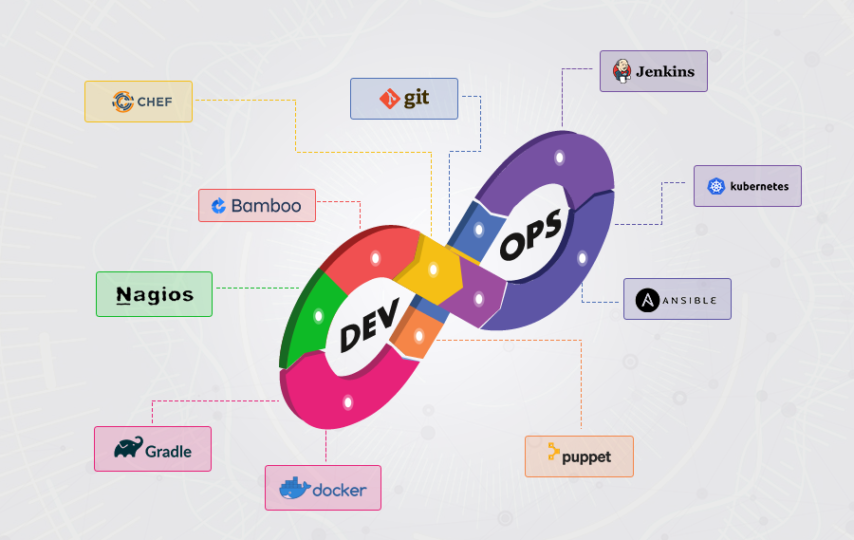To accelerate the time-to-market & prevent project delivery delays, DevOps started to gain popularity from 2009. Typically, DevOps helps to bridge the communication gap between the Development and Operation teams. However to completely harness the power of DevOps, each business should enable integration, continuous delivery and continuous deployment model diligently.
DevOps Tools
However, to streamline DevOps process into any organizations agile methodology needs to be implemented. To facilitate this process, there are various DevOps tools available which evolves with the growing technologies. DevOps tools help to identify and track dependencies, plan their releases and sprints in a systematic way.
Top 10 DevOps Tools List
Let’s delve deep into some of the most widely used DevOps tools in the market today.
1.Gradle
Launched in 2009, Gradle is a reliable build tool for the DevOps tool stack. It’s an open-source construction automation tool. As it is a versatile tool, the codings are written in C++, Java, Python or any programming language. Gradle supports a wide variety of IDE software applications like NetBeans, Eclipse, Intellij IDEA and so on.
The developers can build scripts in Kotlin as well and allows them to import the Ant builds into the Gradle environment. Also, to accelerate the overall build time, Gradle uses Build Cache Beta which reuses the Gradle outputs tasks locally and sends them across the machines. Gradle Daemon improves performance by reusing the computation from previous builds.
Highlight Features
- Incremental builds which implies they can save compilation time
- 100x times faster than Maven
- For Android, Gradle is declared as the Official build tool by Google
- Instead of XML, Gradle uses Groovy based Domain Specific Language
- Gradle Daemon is in-built from Gradle 3.0 version
2. Git
Torvald introduced this brilliant DevOps tool which remains the favourite DevOps tool among the software industries. It is evident from the fact that Microsoft acquired it for 7,500 million dollars. Git became more popular since it allows the developers to record different versions of the source codes and thus they can experiment with it and choose what works best for them.
Git is a source code management tool which effectively used for large organization projects along with cryptographic authentication security system. Software Giants like Facebook, Google, Netflix, Microsoft, Netflix use Git in their Continuous Integration & Continuous delivery cycle. GitHub and BitBucket are the popular Git repository hosting services that seamlessly integrate Git into the DevOps workflow.
Highlight Features:
- Flexibility switch between different source codes.
- Immediate rollbacks in case of error or fallouts
- GitHub provides free access to public repos
- Rapid iterations of codes are possible
- Packfiles, newly created files in a network byte stream, helps to reduce the storage space for developers
3. Jenkins
Jenkins is a widely used DevOps automation tool. It helps in automating the continuous delivery process of a software project and Jenkins is one of the most widely used tools among many devops service providers as well. Jenkins increase the throughput of the overall project life cycle, as Jenkins automates every task and activity in the SDLC.
This open-source continuous integration server collaborates and integrates with most of the DevOps tools from Docker to Puppet. Jenkin provides transparency between the teams, whenever a developer automates & updates the code it is simultaneously visible to QA team and testing server.
Highlight Features:
- Pipeline feature allows automatic code into repository & run test cases
- Instant feedback which quickly alerts for any broken build in any sprints
- Jenkins has over 1000 plugins in the database
- Provides easy installation with Docker
4. Docker
The most famous DevOps tool that is used in the deployment stage is Docker. Since its inception in 2013, Docker constantly remains as the number one preference as the container platform. This container technology can be quickly implemented into any machine irrespective of the base host platform.
Docker engine can run on a remote environment without any issues. Each container consists of source code4, configuration files, other supporting files that are responsible for application deployment. With the help of a virtual container, any applications and their dependencies can be executed on any server at a later time as well.
Highlight Features
- Lightweight tool
- Faster execution & quick debug of the applications
- It has a User-friendly API
- Docker applications are platform & OS independent
- Provides high flexibility & portability for the applications
5. Kubernetes
A group of engineers from Google, in 2015 came up with a new concept to manage the containers in a systematic way. Kubernetes came into practise where it provided a facility to group the containers into separate logical units.
Kubernetes, an open-source system certainly takes the container technology to the next level. It helps in automated deployment, scaling and managing the container applications. Each Kubernetes cluster contains one master node and several worker nodes. Kubernetes, an open-source system, certainly takes the container technology to the next level. It helps in automated deployment, scaling and managing the container applications. Each kubernetes admission controller cluster contains one master node and several worker nodes.
Highlight features:
- Automate & manage 100’s of containers easily
- Closely monitors every activity between the containers
- Quickly redistributes the containers whenever a worker node is down.
- Improves the fault tolerance level
6. Ansible
Ansible is an effective configuration management tool that is used to effectively configure the infrastructure and automate the deployment process quickly. Ansible has many modules that provide a secure and lightweight solution. To run the applications it only requires SSH.
Ansible is easy to use DevOps tools which acts as the backbone if an automated cluster environment. It typically works in a client-server model. Many devops service providers prefer this tool to minimize the overall project development cost.
Highlight Features:
- Agentless architecture which means no daemons will run in the background
- Follows a simple syntax known as YAML
- It is software-independent to run
- Provisioning
- Lowers the infrastructure Cost
7. Puppet
Puppet is better than Ansible in terms of having good control over the client machines. Also, it has a GUI and agent-based tool which makes a better choice than Ansible. It is an open source configuration management tool that supports cross platforms.
For larger organizations, Puppet Enterprise seamlessly manages several teams along with thousands of resources.
Highlight Features:
- Supports 100’s of external tools
- Have more than 5000 modules
- Puppet instantly understands the inherent relationships
- Applications can be deployed quickly and safely.
8. Nagios
Nagios is exclusively created as a continuous monitoring tool. Three main categories namely application, network, and server are monitored closely. Nagios supports NRPE plugins and allows many plugins to be added freely.
Whenever there is any backlash or downtime in the backend processes especially in large complex project life cycle, this tool identifies the specific circuit from a pool of servers, routers, etc.
Highlight Features:
- A single server is sufficient to monitor an entire data center
- GUI interface gives in-depth details like memory usage, fan speed, etc
- Keep tracks of outages and failures for future reference
- Prompt Alert notifications for any unexpected failures
9. Chef
Another powerful configuration management tool that is used to quickly manage, configure and deploy the servers is the Chef DevOps tool. To easily integrate with any infrastructure, it supports API from Azure, Amazon Web Server, and Rackspace.
Chef follows master agent architecture with three main components namely server, workstation, and nodes.
Highlight Features:
- Highly scalable
- Can manage up to 50000 nodes
- Manage multiple cloud environment
10. Bamboo
Bamboo is Atlassian’s CI/CD server solution that tests, compile and automate processes all in a single workflow. Unlike Jenkins, Bamboo has many in-built functions which is the reason for having fewer plugins. Bamboo helps to build multiple compilation plans and assign the appropriate agents.
Bamboo easily integrates into other Atlassian products such as Jira and Bitbucket. It has a simple user interface and comes with cool features like auto-completion, tooltips to quicken the overall process.
Highlight Features:
- Saves configuration time
- Access to built-in Git Workflows
- Easy integration with other Atlassian tools
- Gives out-of-the-box solutions
- Quickly identifies error through parallel testing
Wrapping Up
Though implementing a new DevOps tool into your existing development process may take a few trials and experiments, this top ten lists will certainly give you a heads up about the best DevOps tool in the market as of now. Many of these tools come with a free trial period which gives room to test and check whether it suits your business goals and budget. However, choosing a devops service provider who uses any of these above mentioned tools is the best approach for your projects. If you think to add some more DevOps tools to the list, feel free to add it in the comment section below.





